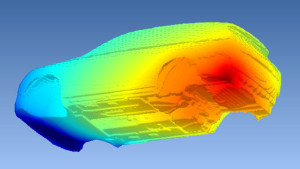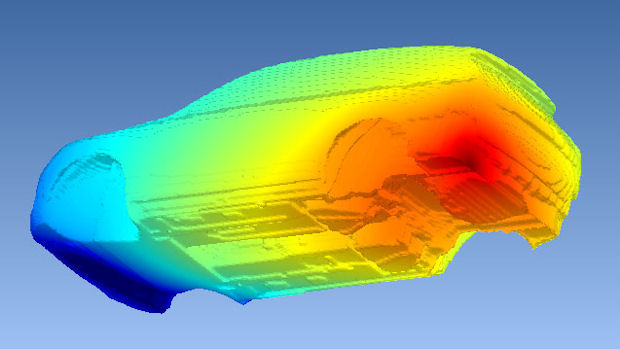
Pressure distribution around a car body due to a sound source at the exhaust orifice is pictured. Image courtesy of Volvo.
Over at Desktop Engineering, Frank J. Ohlhorst writes that Volvo is pushing the boundaries of NVH (noise, vibration and harshness) simulation in order to improve the quality of new automobiles.
Volvo Cars’ Andrzej Pietrzyk, advanced engineering leader, Body and Vehicle NVH CAE, says his group uses several different products to focus on their core tasks of supporting new product development. “In NVH CAE, the focus of MSC Software products is on body NVH, so the typical analyses are evaluating the dynamic stiffness, vibration transfer functions, noise transfer functions and acoustic transfer functions,” he says. Volvo has adopted several modules from MSC, including Nastran, 2013.1 and 2014.0, MSC Actran v14.1, v15.0, MSC Adams, and MSC Marc and other modules. Naturally, running all of those modules takes some serious computing power, explains Pietrzyk. Currently, we have a set of multi-node servers, typically using state-of-the-art processors, lots of memory and large advanced disk systems,” he says. “We run on 50 nodes, each equipped with double Intel Xeon E5 8-core CPUs, 256GB memory and 5TB fast disk systems.”
To get the job done, Volvo uses MSC Nastran ACM, which divides workloads across multiple domains using distributed memory parallel processing.
For those applications, we can cut the solution time by a factor of 4-5 by running on several hosts simultaneously,” he says. “In applications involving the SOL 108 (a select solution sequence in Nastran) procedure, the scaling is linear, meaning that adding more hosts results in the corresponding reduction of the solution time. Running on 16 hosts instead of one leads to the solution time being cut by a factor of 16.”




